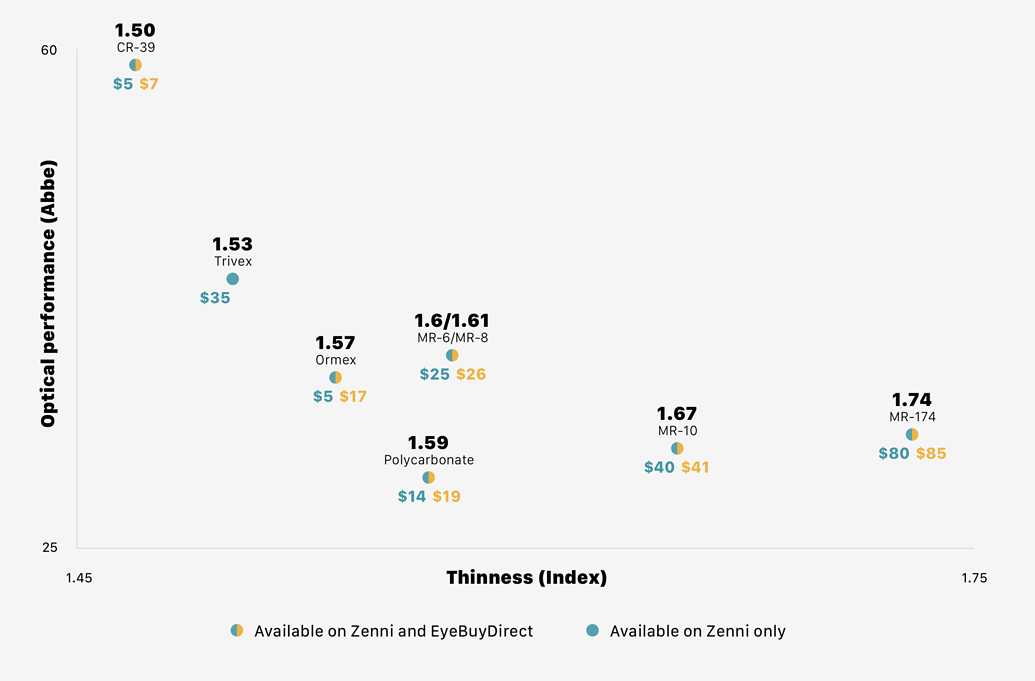Difference between revisions of Chromatic Aberration
Dlskidmore (talk | contribs) m (→Duochrome test: I think there is signs confusion here. Need to re-work the wording that is not backwards when signs are considered.) |
|||
| (3 intermediate revisions by 2 users not shown) | |||
| Line 3: | Line 3: | ||
[[File:Chromatic aberration lens diagram.svg|Chromatic aberration lens diagram]] | [[File:Chromatic aberration lens diagram.svg|Chromatic aberration lens diagram]] | ||
= Duochrome test = | == Duochrome test == | ||
{| class="wikitable" | {| class="wikitable" | ||
|- | |- | ||
| Line 17: | Line 17: | ||
<youtube>WP6eeoyB9go</youtube> | <youtube>WP6eeoyB9go</youtube> | ||
= External Sources = | == External Sources == | ||
* [[Wikipedia:Chromatic aberration]] | * [[Wikipedia:Chromatic aberration]] | ||
* [[Wikipedia:Duochrome test]] | * [[Wikipedia:Duochrome test]] | ||
== Lens Material == | |||
Different materials have different [https://en.wikipedia.org/wiki/Abbe_number Abbe numbers]. Materials with higher values are better, since they tend to have less chromatic aberration. | |||
Here are some typical values:<ref>https://www.allentownoptical.com/abbe-value-interpretation/</ref> | |||
{| class="wikitable sortable" | |||
!Material | |||
!Index | |||
!Abbe Value | |||
|- | |||
|Crown Glass | |||
|1.523 | |||
|59 | |||
|- | |||
|High Index Glass | |||
|1.60 | |||
|42 | |||
|- | |||
|High Index Glass | |||
|1.70 | |||
|39 | |||
|- | |||
|Plastic CR-39 | |||
|1.49 | |||
|58 | |||
|- | |||
|Mid Index Plastic | |||
|1.54 | |||
|47 | |||
|- | |||
|Mid Index Plastic | |||
|1.56 | |||
|36 | |||
|- | |||
|High Index Plastic | |||
|1.60 | |||
|36 | |||
|- | |||
|High Index Plastic | |||
|1.66 | |||
|32 | |||
|- | |||
|Trivex | |||
|1.53 | |||
|43 | |||
|- | |||
|Polycarbonate | |||
|1.58 | |||
|30 | |||
|- | |||
|MR-174 | |||
|1.74 | |||
|32 | |||
|} | |||
[[File:Lens materials and optical quality chart.png|Lens materials and optical quality chart]] | |||
[https://community.endmyopia.org/t/lens-materials-and-optical-quality-chart/4415 chart created by steadicat] | |||
=== Tradeoff Between Chromatic Aberration vs Distortion === | |||
When choosing lens index, remember to take into account overall distortion at the edges of the lens. Too much overall distortion may make it difficult to view the edges of the lenses. | |||
[https://endmyopia.org/need-high-index-lenses/ EndMyopia: Do You Need High Index Lenses?] | |||
The following vendor articles may be of interest: | |||
* [https://www.zennioptical.com/glasses-lenses Zenni] | |||
* [https://www.eyebuydirect.com/prescription-lens/lens-index EyeBuyDirect] | |||
* [https://www.selectspecs.com/guides/lenses/single-vision/ SelectSpecs] | |||
* [https://www.framesbuy.com/trends/lens-index/ FramesBuy] | |||
Anecdotally from the forums, -3 is a balanced cutoff range for CR-39 where one can take advantage of higher abbe and competitive cost, without experiencing too much distortion at lens edges. Outside of that range, consider higher index lenses to minimize distortion. | |||
==References== | ==References== | ||
Latest revision as of 04:49, 18 September 2022
Chromatic aberration is probably most easily understood as a prism effect. When light shines through a prism, you see that different colors of light bend (undergo Refraction) differently and create a rainbow effect. When light shines through any lens, including glasses and the natural lens of your eye, the same occurs to a lesser degree. The effect of this is that the Focal Length of the lens is not exactly the same for all colors of light.
Duochrome test
| KH | HK |
|---|---|
| EPO | OPE |
The chromatic aberration expected during a normal eye exam is about a half diopter difference between red and green. This can be a handy test to dial in a final prescription by looking at text on red and green backgrounds and seeing which is clearer.
External Sources
Lens Material
Different materials have different Abbe numbers. Materials with higher values are better, since they tend to have less chromatic aberration.
Here are some typical values:[1]
| Material | Index | Abbe Value |
|---|---|---|
| Crown Glass | 1.523 | 59 |
| High Index Glass | 1.60 | 42 |
| High Index Glass | 1.70 | 39 |
| Plastic CR-39 | 1.49 | 58 |
| Mid Index Plastic | 1.54 | 47 |
| Mid Index Plastic | 1.56 | 36 |
| High Index Plastic | 1.60 | 36 |
| High Index Plastic | 1.66 | 32 |
| Trivex | 1.53 | 43 |
| Polycarbonate | 1.58 | 30 |
| MR-174 | 1.74 | 32 |
Tradeoff Between Chromatic Aberration vs Distortion
When choosing lens index, remember to take into account overall distortion at the edges of the lens. Too much overall distortion may make it difficult to view the edges of the lenses.
EndMyopia: Do You Need High Index Lenses?
The following vendor articles may be of interest:
Anecdotally from the forums, -3 is a balanced cutoff range for CR-39 where one can take advantage of higher abbe and competitive cost, without experiencing too much distortion at lens edges. Outside of that range, consider higher index lenses to minimize distortion.

